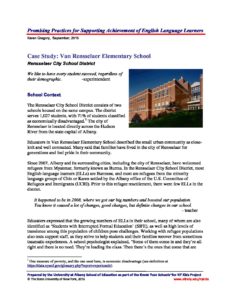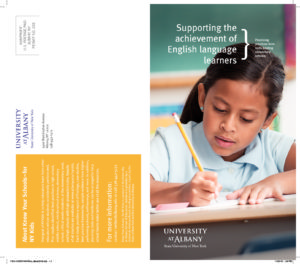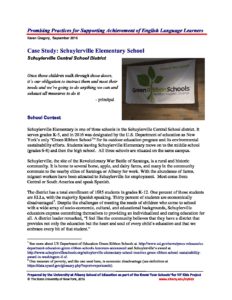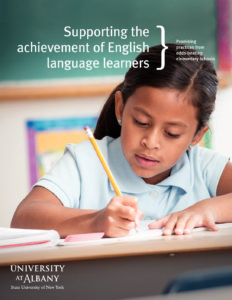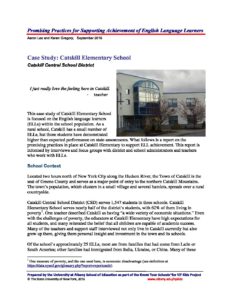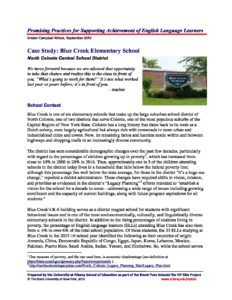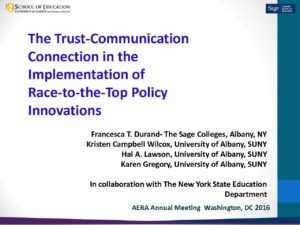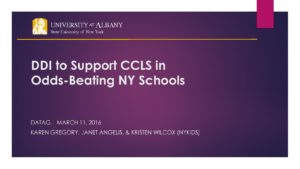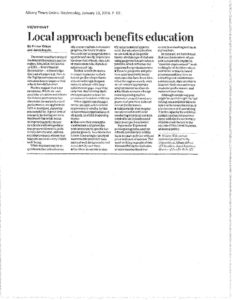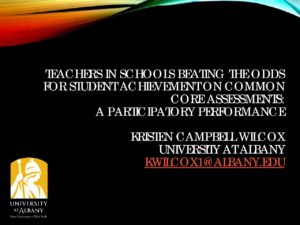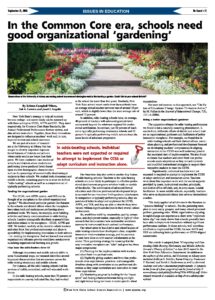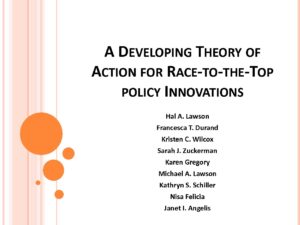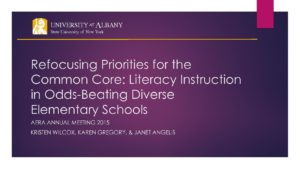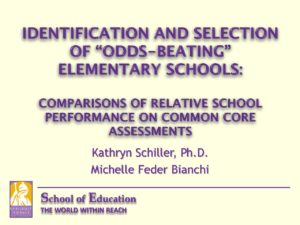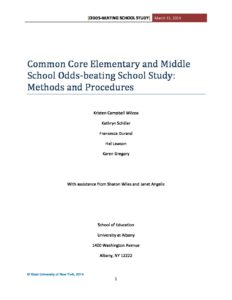A primary activity of NYKids is to conduct research and identify promising practices in odds-beating schools.
Results of each study are available in multiple formats and include reports that summarize the results of each study; best practice frameworks that offer comparisons of higher- and typically-performing schools and sample documents from the odds-beating performers; and case studies of the individual higher-performing, odds-beating schools studied.
Apply Any Combination of Filters to Refine Your Results
Filters
Search Results (195)
The ELL population in New York State has grown over 20% in the last year, and ELLs now make up over 8% of the New York State student population. Odds-beating schools have systems in place to carefully monitor the progress of their ELLs, connected to systems of interventions for students who need more support.
The ELL population in New York State has grown over 20% in the last year, and ELLs now make up over 8% of the New York State student population. Odds-beating schools have systems in place to carefully monitor the progress of their ELLs, connected to systems of interventions for students who need more support. State English Language Arts and Math assessment data and language proficiency assessment data do not tell the whole story: formative and benchmark assessment are more informative. Systematic reporting and communication/dissemination of multiple measures of student performance allows educators and families to meet the needs of all students.
The English Language Learner population in New York State has grown over 20%, and English Language Learners make up over 8% of the New York State student population. Four components are important to educating the ELL population including: (1) climate and culture; (2) instruction; (3) leadership & capacity; and (4) communication and collaboration.
The English Language Learner population in New York State has grown over 20%, and English Language Learners make up over 8% of the New York State student population. Four components are important to educating the ELL population including: (1) climate and culture; (2) instruction; (3) leadership & capacity; and (4) communication and collaboration.
In 2015-16, research teams investigated 6 elementary schools. In comparison to schools serving similar populations at each grade level, these odds-beating schools are ones in which English Language Learners exceeded expected average performance.
This case study is one of a series of studies conducted by Know Your Schools~for NY Kids since 2005. In 2015-16, research teams investigated 6 elementary schools. In comparison to schools serving similar populations at each grade level, these odds-beating schools are ones in which English Language Learners exceeded expected average performance on the 2012-13 and 2013-14 state mathematics and English language arts assessments across multiple grade levels and subjects. Comparisons were for grades three through six. Researchers used site-based interviews of teachers and administrators, as well as analyses of supportive documentation in all schools; in four of the schools student interviews and classroom observations were also conducted.
In 2015-16, research teams investigated 6 elementary schools. In comparison to schools serving similar populations at each grade level, these odds-beating schools are ones in which English Language Learners exceeded expected average performance.
This case study is one of a series of studies conducted by Know Your Schools~for NY Kids since 2005. In 2015-16, research teams investigated 6 elementary schools. In comparison to schools serving similar populations at each grade level, these odds-beating schools are ones in which English Language Learners exceeded expected average performance on the 2012-13 and 2013-14 state mathematics and English language arts assessments across multiple grade levels and subjects. Comparisons were for grades three through six. Researchers used site-based interviews of teachers and administrators, as well as analyses of supportive documentation in all schools; in four of the schools student interviews and classroom observations were also conducted.
In 2015-16, research teams investigated 6 elementary schools. In comparison to schools serving similar populations at each grade level, these odds-beating schools are ones in which English Language Learners exceeded expected average performance.
This case study is one of a series of studies conducted by Know Your Schools~for NY Kids since 2005. In 2015-16, research teams investigated 6 elementary schools. In comparison to schools serving similar populations at each grade level, these odds-beating schools are ones in which English Language Learners exceeded expected average performance on the 2012-13 and 2013-14 state mathematics and English language arts assessments across multiple grade levels and subjects. Comparisons were for grades three through six. Researchers used site-based interviews of teachers and administrators, as well as analyses of supportive documentation in all schools; in four of the schools student interviews and classroom observations were also conducted.
In 2015-16, research teams investigated 6 elementary schools. In comparison to schools serving similar populations at each grade level, these odds-beating schools are ones in which English Language Learners exceeded expected average performance.
This case study is one of a series of studies conducted by Know Your Schools~for NY Kids since 2005. In 2015-16, research teams investigated 6 elementary schools. In comparison to schools serving similar populations at each grade level, these odds-beating schools are ones in which English Language Learners exceeded expected average performance on the 2012-13 and 2013-14 state mathematics and English language arts assessments across multiple grade levels and subjects. Comparisons were for grades three through six. Researchers used site-based interviews of teachers and administrators, as well as analyses of supportive documentation in all schools; in four of the schools student interviews and classroom observations were also conducted.
In 2015-16, research teams investigated 6 elementary schools. In comparison to schools serving similar populations at each grade level, these odds-beating schools are ones in which English Language Learners exceeded expected average performance.
This case study is one of a series of studies conducted by Know Your Schools~for NY Kids since 2005. In 2015-16, research teams investigated 6 elementary schools. In comparison to schools serving similar populations at each grade level, these odds-beating schools are ones in which English Language Learners exceeded expected average performance on the 2012-13 and 2013-14 state mathematics and English language arts assessments across multiple grade levels and subjects. Comparisons were for grades three through six. Researchers used site-based interviews of teachers and administrators, as well as analyses of supportive documentation in all schools; in four of the schools student interviews and classroom observations were also conducted.
In 2015-16, research teams investigated 6 elementary schools. In comparison to schools serving similar populations at each grade level, these odds-beating schools are ones in which English Language Learners exceeded expected average performance.
This case study is one of a series of studies conducted by Know Your Schools~for NY Kids since 2005. In 2015-16, research teams investigated 6 elementary schools. In comparison to schools serving similar populations at each grade level, these odds-beating schools are ones in which English Language Learners exceeded expected average performance on the 2012-13 and 2013-14 state mathematics and English language arts assessments across multiple grade levels and subjects. Comparisons were for grades three through six. Researchers used site-based interviews of teachers and administrators, as well as analyses of supportive documentation in all schools; in four of the schools student interviews and classroom observations were also conducted.
In 2015-16, research teams investigated 6 elementary schools. In comparison to schools serving similar populations at each grade level, these odds-beating schools are ones in which English Language Learners exceeded expected average performance.
This case study is one of a series of studies conducted by Know Your Schools~for NY Kids since 2005. In 2015-16, research teams investigated 6 elementary schools. In comparison to schools serving similar populations at each grade level, these odds-beating schools are ones in which English Language Learners exceeded expected average performance on the 2012-13 and 2013-14 state mathematics and English language arts assessments across multiple grade levels and subjects. Comparisons were for grades three through six. Researchers used site-based interviews of teachers and administrators, as well as analyses of supportive documentation in all schools; in four of the schools student interviews and classroom observations were also conducted.
In 2015-16, research teams investigated 6 elementary schools. In comparison to schools serving similar populations at each grade level, these odds-beating schools are ones in which English Language Learners exceeded expected average performance.
This case study is one of a series of studies conducted by Know Your Schools~for NY Kids since 2005. In 2015-16, research teams investigated 6 elementary schools. In comparison to schools serving similar populations at each grade level, these odds-beating schools are ones in which English Language Learners exceeded expected average performance on the 2012-13 and 2013-14 state mathematics and English language arts assessments across multiple grade levels and subjects. Comparisons were for grades three through six. Researchers used site-based interviews of teachers and administrators, as well as analyses of supportive documentation in all schools; in four of the schools student interviews and classroom observations were also conducted.
The presentation describes the association between trust and communication during policy innovation and implementation.
The presentation describes the association between trust and communication during policy innovation and implementation.
The study identifies the school practices and policies found in elementary and middle schools whose students exceeded performance expectations on the 2012-13 New York State assessments.
The study identifies the school practices and policies found in elementary and middle schools whose students exceeded performance expectations on the 2012-13 New York State assessments. This presentation considers how educators approach data-driven instruction, the types of data used and for what purposes, and practices or processes to support data-driven instruction.
This article discusses the recent reauthorization of the federal Elementary and Secondary Education Action, known as Every Student Succeeds Act (ESSA).
The recent reauthorization of the federal Elementary and Secondary Education Action, known as ESSA – Every Student Succeeds Act – acknowledges that past attempts (e.g. Race to the Top) by government to tell educators how to improve their schools have fallen short. Studies suggest that’s not surprising. While we commend the attention and efforts the federal government has shown for the nation’s school performance, we applaud the shift to localized, statewide accountability. A great deal of research, including our own, has found that what works in improving performance in schools is allowing educators to use evidence to guide locally determined, continuous improvement efforts that take into account every child’s well-being.
The primary purpose for the proposed research was to identify the school practices and policies found in elementary and middle schools whose students exceeded performance expectations on New York State Common Core assessments (as well as those that were used prior to Common Core).
The primary purpose for the proposed research was to identify the school practices and policies found in elementary and middle schools whose students exceeded performance expectations on New York State Common Core assessments (as well as those that were used prior to Common Core).
This presentation identifies the school practices and polices found in elementary and middle schools whose students exceeded performance expectations on the 2012-13 New York State assessments, which were the first aligned with the Common Core Standards.
This presentation identifies the school practices and polices found in elementary and middle schools whose students exceeded performance expectations on the 2012-13 New York State assessments, which were the first aligned with the Common Core Standards.
This presentation presents on a study that investigated school leadership team participants’ perceptions of an intervention called COMPASS. COMPASS engages teams from different schools and districts in activities to identify strengths, weaknesses, and priorities then engage in an inquiry cycle of implementing action plans, gathering data and interpreting evidence in order to reach targeted goals.
This qualitative multiple case study contributes to the growing body of translational research that
seeks to better understand what is needed to develop capacities for evidence-guided continuous
improvement in P-12 settings. The study investigated school leadership team participants’
perceptions of an intervention called COMPASS. COMPASS engages teams from different
schools and districts in activities to identify strengths, weaknesses, and priorities then engage in
an inquiry cycle of implementing action plans, gathering data and interpreting evidence in order
to reach targeted goals. Two-hundred and twenty-eight district and school leaders and
instructional staff from 36 school teams provided reflections on the intervention revealing the
majority reported increases in competence in all dimensions of evidence-guided decision
making, from priority and goal setting to identifying potential research-based levers to
improvement as well as increased capacities for school- and district-wide action planning and
progress monitoring. Observation field notes, documentary evidence, and interviews with school
leaders also indicate that the process fundamentally shifts educators’ focus on systemic changes
to achieve system-wide targeted goals. Implications for theory, future research, and
considerations for those interested in university/P-12 partnerships for continuous improvement
are discussed.
This article discusses important organizational features of districts and schools whose early results on the Common Core Assessments are better than their peer schools.
This article discusses important organizational features of districts and schools whose early results on the Common Core Assessments are better than their peer schools. The Common Core State Standards, Annual Professional Performance Review system and Data-Driven Instruction can be thought of as transplants to the school organizational “garden.” Findings suggest particular garden-like features in the schools and district offices where the transplants have taken hold and students are performing above predicted levels.
This presentation identifies the school practices and polices found in elementary and middle schools whose students exceeded performance expectations on the 2012-13 New York State assessments, which were the first aligned with the Common Core Standards.
This presentation identifies the school practices and polices found in elementary and middle schools whose students exceeded performance expectations on the 2012-13 New York State assessments, which were the first aligned with the Common Core Standards.
Presentation of the findings from a comparative study of New York State schools designed to investigate implementation of Common Core Learning Standards (CCLS) and the Annual Professional Performance Review (APPR) as they relate to student performance outcomes on CCLS-aligned assessments.
Presentation of the findings from a comparative study of New York State schools designed to investigate implementation of Common Core Learning Standards (CCLS) and the Annual Professional Performance Review (APPR) as they relate to student performance outcomes on CCLS-aligned assessments.
Presentation of the findings from a comparative study of New York State schools designed to investigate implementation of Common Core Learning Standards (CCLS) and the Annual Professional Performance Review (APPR) as they relate to student performance outcomes on CCLS-aligned assessments.
Presentation of the findings from a comparative study of New York State schools designed to investigate implementation of Common Core Learning Standards (CCLS) and the Annual Professional Performance Review (APPR) as they relate to student performance outcomes on CCLS-aligned assessments.
Presentation of the findings from a comparative study of New York State schools designed to investigate implementation of Common Core Learning Standards (CCLS) and the Annual Professional Performance Review (APPR) as they relate to student performance outcomes on CCLS-aligned assessments.
Presentation of the findings from a comparative study of New York State schools designed to investigate implementation of Common Core Learning Standards (CCLS) and the Annual Professional Performance Review (APPR) as they relate to student performance outcomes on CCLS-aligned assessments.
Presentation of the findings from a comparative study of New York State schools designed to investigate implementation of Common Core Learning Standards (CCLS) and the Annual Professional Performance Review (APPR) as they relate to student performance outcomes on CCLS-aligned assessments.
Presentation of the findings from a comparative study of New York State schools designed to investigate implementation of Common Core Learning Standards (CCLS) and the Annual Professional Performance Review (APPR) as they relate to student performance outcomes on CCLS-aligned assessments.
Presentation of the findings from a comparative study of New York State schools designed to investigate implementation of Common Core Learning Standards (CCLS) and the Annual Professional Performance Review (APPR) as they relate to student performance outcomes on CCLS-aligned assessments.
Presentation of the findings from a comparative study of New York State schools designed to investigate implementation of Common Core Learning Standards (CCLS) and the Annual Professional Performance Review (APPR) as they relate to student performance outcomes on CCLS-aligned assessments.
Presentation of the findings from a comparative study of New York State schools designed to investigate implementation of Common Core Learning Standards (CCLS) and the Annual Professional Performance Review (APPR) as they relate to student performance outcomes on CCLS-aligned assessments.
Presentation of the findings from a comparative study of New York State schools designed to investigate implementation of Common Core Learning Standards (CCLS) and the Annual Professional Performance Review (APPR) as they relate to student performance outcomes on CCLS-aligned assessments.
A systematic examination of the ways a variety of schools have approached and responded to the Common Core Learning Standards (CCLS) and the Annual Professional Performance Review (APPR) systems, both part of the Race to the Top reform agenda.
The Common Core Odds-Beating Studies were developed in collaboration between a team of researchers at the University at Albany and the New York State Education Department. The study began in the recognition that there was a need for research investigating the process and practices in schools with relatively better outcomes on the Common Core-aligned assessments first implemented in the state in the 2011-2012 school year. At the time of this study, there had been no systematic examinations of the ways a variety of schools have approached and responded to the Common Core Learning Standards (CCLS) and the Annual Professional Performance Review (APPR) systems, both part of the Race to the Top reform agenda.



